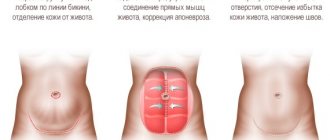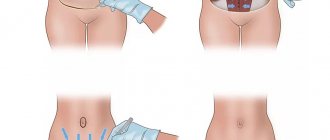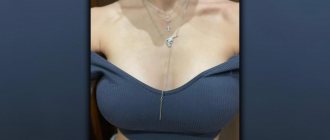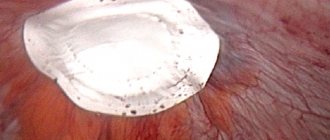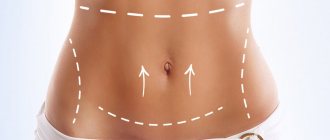More about body plastic surgery...
Thigh lift / Upper body lift /
The ancients considered the navel to be the center of energy and strength, but we know that it is just a scar left from tying the umbilical cord. It does not perform any useful functions. But despite such a modest role in the body, a beautiful, neat navel still attracts interested glances and is considered erotic and seductive. But not everyone manages to get an exemplary belly button from the very beginning. But it's not that scary. A small, simple operation and navel plastic surgery will correct the oversight of a careless midwife.
Navel surgery (umbilicoplasty)
After pregnancy or sudden weight loss, it is not always possible to maintain a neat navel, because stretch marks and excess folds may appear. Such imperfections prevent patients from enjoying their figure. A plastic surgeon will help correct the deficiency through umbilicoplasty or navel surgery. This operation is considered small in scope, but can give a good result that will please the patient.
Patients usually seek belly button surgery after significant weight loss, multiple pregnancies, unsuccessful abdominal surgery, or a belly button piercing that has caused an allergic or inflammatory reaction in the body, leaving noticeable scars on the skin.
How is abdominoplasty with navel transfer performed?
Immediately before the operation, markings are applied to the correction area, which allows you to determine the amount of tissue to be removed and the location of the navel movement. The skin is then treated with an antiseptic solution and the patient is given anesthesia.
At the beginning of the main stage of the operation, the surgeon makes 2 incisions: around the navel and in the pubic area (transverse). Then the surgeon separates the skin and subcutaneous fat from the anterior abdominal wall, removes excess fat and skin, and tightens the aponeurosis of the abdominal muscles. During this stage, in the presence of fat deposits, liposuction of the anterior and lower abdominal walls is performed using the Vaser device. Using thin cannula needles, the surgeon removes excess fatty tissue, thereby smoothing the transition zones of the abdominal curves.
During the operation, hernias are also removed and diastasis is sutured. At the next stage, the surgeon stretches the tissues of the upper abdomen towards the womb, then moves and fixes the navel in a new position. Next, sutures are applied, the wounds are re-treated with an antiseptic solution, and drains are installed to ensure the outflow of fluid and blood. Immediately after the operation, the patient is put on compression garments.
What is navel surgery (umbilicoplasty)?
Ubilicoplasty is a plastic surgery aimed at correcting the navel by excision of tissue and removal of excess skin. Belly button surgery is considered a simple operation with little rehabilitation. It can be performed either locally or as part of abdominoplasty or abdominal liposuction. The scope of the intervention is determined by the plastic surgeon after consultation, having carefully examined the condition of the patient’s tissues and listened to his wishes.
Sometimes, to obtain a good result, it is necessary to combine navel correction with the removal of local fat deposits (abdominal liposuction) and the removal of the skin-fat apron by liposuction. In such cases, local correction of the navel will not bring the desired effect, so it is worth listening to the opinion of a specialist and performing the entire scope of the operation.
NAMLIK CORRECTION IN THE PIROGOV CLINIC IS AN OPERATION IN THE BEST PLASTIC SURGERY CLINIC IN ST. PETERSBURG.
*according to the ratings of the portals “Doctor Peter” and “Fontanka.ru” in 2021. Read more.
How is navel surgery performed - umbilicoplasty?
As noted earlier, there are several types of navel correction surgery. The general steps for each of them are as follows. Before the correction begins, the operating area is carefully treated with an antiseptic, the patient is immersed in a state of anesthesia (depending on the complexity of the operation, both local and general anesthesia can be used). The surgeon then makes the necessary incisions and forms a new vertical fossa in the natural fold.
When correcting a bulge, excess tissue is resected and the navel is deepened manually. If it is necessary to change the size of the umbilical ring, the surgeon, through a small incision, adjusts the flap of skin using the method of “untying” and then sewing it back. If the purpose of umbilicoplasty is reconstruction after injury, the deformed abdominal tissue is excised and a new cone-shaped hole is created in its place. If during surgery it is necessary to eliminate a hernia, the surgeon first corrects the pathology, and then strengthens the abdominal wall and sutures the navel.
At the final stage, regardless of the type of surgical intervention, sutures and a sterile bandage are applied.
Navel surgery after childbirth.
Many young mothers note that after childbirth, the navel became deformed and ceased to satisfy them. Due to tissue tension, the navel may droop or develop an unsightly fold above the umbilical ring. In this case, it is recommended to perform a navel correction and eliminate the imperfections that the woman does not like. As a rule, patients who, in addition to navel surgery, require mini-abdominoplasty, abdominoplasty, elimination of diastasis, or umbilical hernia repair, turn to a plastic surgeon for help. The defects can be corrected during one simultaneous operation, which will give the desired result and return the patient to a flat stomach.
Navel surgery. Indications
Medical indications for umbilicoplasty, i.e. navel plastic surgery as such. The only sufficient reason for performing the operation is the patient’s desire. If the appearance of your navel does not satisfy you, the surgeon will give it the shape you want. Most often, patients come to solve the following aesthetic problems:
- Protruding navel in the form of a button
- Consequences of a bad piercing
- A navel that is stretched and deformed due to pregnancy or significant weight gain
- Displacement, deformation, asymmetrical location of the navel after abdominal surgery or unsuccessful abdominoplasty
- Complete loss of the navel due to injury or surgery
But sometimes other wishes are heard - for example, to correct a too deep or T-shaped navel. Some even turn to plastic surgeons to get rid of the belly button completely!
Indications for surgery.
Indications for navel surgery are aesthetic dissatisfaction with the shape of the umbilical ring, which was this way by nature or acquired this appearance after pregnancy or sudden weight loss. There are also consequences of unsuccessful piercing or extensive surgery on the abdominal wall, which affect the shape of the navel. Thanks to modern methods of aesthetic medicine, it is possible to correct even complex cases. Over time, neat scars will form at the site of the incisions, which over time become almost invisible if the patient has good tissue scarring.
Rehabilitation
Recovery time after surgery depends on the method of removal. To quickly undergo rehabilitation, the patient must adhere to the rules of rehabilitation:
- wearing a compression bandage after the stitches have healed;
- refusal of physical activity for up to 6 months, resumption with a doctor’s permission;
- postoperative diet with eating small portions (prevents intestinal pressure on the abdominal wall) without gas-forming products;
- use of medications prescribed by the surgeon (antibiotics, painkillers);
- antiseptic treatment of seams;
- after healing of the sutures, massage, therapeutic exercises, and physiotherapy are indicated;
- periodic examination by a doctor.
When performing an operation in our Moscow clinics, the surgeon makes minimal incisions, uses modern suture material, and applies a cosmetic suture. The rehabilitation period when using implants is reduced. Our patients receive everything they need to effectively repair an umbilical hernia.
Preparing for surgery.
After the date of the operation has been set, it will be necessary to undergo preoperative tests, the list of which depends on the anesthesia under which it is decided to perform the operation - general or local. If ubilicoplasty is supposed to be of small volume, then it can be performed under local anesthesia. If the navel correction is performed as part of a full abdominoplasty, then the operation will require a full Standard C examination, which includes laboratory tests of blood, urine, biochemical blood test, X-ray, ECG, as well as the conclusion of a general practitioner and anesthesiologist.
Rehabilitation period after abdominoplasty with navel transfer
The patient spends several days after the operation under the supervision of doctors. The duration of complete rehabilitation largely depends on the extent of the surgical intervention and the general health of the patient and can range from 1 to 3 months. During the recovery period, the patient should follow the doctor’s recommendations:
- wear compression garments (from 1 month);
- follow a diet;
- for 2 months, exclude physical activity, refuse to visit the bathhouse, sauna and solarium;
- exclude exposure to direct sunlight on the postoperative suture;
- do not sleep on your stomach;
- perform a set of special exercises to maintain the tone of the abdominal muscle corset;
- Limit your habitual smoking and drinking habits.
Progress of the operation.
The scope of the operation depends on the necessary manipulations. If the patient is indicated for local correction of the navel, then the plastic surgeon will excise the tissue and form a neat umbilical ring. In this case, as a rule, 1.5 hours is enough, after which the specialist applies stitches.
If the scope of the operation involves performing abdominoplasty and suturing diastasis, then the operation will last about 4 hours. After stitches are applied, special shapewear is put on the patient’s body.
Indications for navel surgery – umbilicoplasty
Reasons for performing umbilicoplasty can be classified into two large groups. The first group includes defects of an aesthetic nature that do not pose a threat to the patient’s health. They can be corrected at the request of the patient in the absence of medical contraindications to surgery. Aesthetic indications include;
- protruding, spherical, T-shaped navel;
- horizontal/vertical asymmetry;
- age-related ptosis of the abdominal region;
- keloid scars left after abdominoplasty that do not cause physical discomfort to the patient;
- sagging as a result of sudden weight loss;
- torn edges of the navel;
- postpartum changes;
- absence of a pit due to deformation;
- excessively wide umbilical ring.
Medical conditions that pose a threat to the patient’s health include:
- hernias;
- accumulation of fluid with a deepened navel;
- gross scarring of tissue;
- injuries, including after piercing (rupture/stretching of the navel).
| Abdominoplasty - abdominoplasty - Anna Petrovna Pershukova | |
| Mini abdominoplasty 1 category of complexity | 180,000 rub. |
| Mini abdominoplasty 2nd category of complexity | RUB 210,000 |
| Vertical abdominoplasty | RUB 220,000 |
| Classic abdominoplasty without navel transfer | RUB 260,000 |
| Classic abdominoplasty with navel transfer | RUB 310,000 |
| Classic abdominoplasty with navel transfer and suturing of diastasis | RUB 355,000 |
| Navel surgery - first degree umbilicoplasty | 95,000 rub. |
| Navel surgery - second degree umbilicoplasty | RUB 115,000 |
| Navel plastic surgery - umbilicoplasty in combination with abdominoplasty | 75,000 rub. |
Expand
Sign up for a consultation
Rehabilitation period.
The rehabilitation period depends on the extent of the operation performed. If only the navel correction was carried out, then the postoperative period passes easily, and after a month and a half a thin scar forms at the site of the incisions.
If the operation included excision of the skin-fat apron, removal of diastasis and formation of a new navel, then the rehabilitation period includes wearing corrective underwear for 2-3 months, which is necessary for favorable tissue healing.
During the rehabilitation period, it is necessary to refrain from active physical activity, visiting the bathhouse, swimming pool, sauna and solarium. It is necessary to return to exercise in the gym after consultation with a plastic surgeon.
Rehabilitation period
After the operation, the patient is under the supervision of medical staff for several hours, and if general anesthesia was given - for a day, and then returns home. For the first few days, some pain in the abdominal area persists, which can be relieved by taking painkillers. During the first week, it is necessary to refrain from water procedures, at least not to wet the navel, and regularly go for dressings. 7 days after surgery, the sutures will be removed (if non-absorbable suture material was used). After this, you can freely take a shower, although not very hot.
To reduce swelling, you should wear compression garments throughout the recovery period. In addition, after removing the sutures, the navel is regularly treated with healing and bactericidal ointments. It is also important to observe some restrictions for two months after plastic surgery: do not overexert yourself physically, avoid thermal procedures and protect the navel from exposure to ultraviolet radiation (to avoid hyperpigmentation).
Just as after any operation, after navel surgery, infection of the sutures (if antiseptic rules are not followed) or the formation of keloid scars can occur. But there are practically no specific complications for this operation. In the vast majority of cases, the result of umbilicoplasty is positive and lasts throughout life. The scars are hidden deep in the navel and are completely invisible.
The cost of plastic surgery can be found in the “Prices” section.
You can make an appointment by calling +7 (495) 505-5235, +7 (901) 745-4775 at any convenient time from Monday to Friday 09-30 to 17-00.
We will be happy to help you!
Copyright information...
Attention! Any copying or distribution of this content is prohibited. Unauthorized copying and use of text entails legal liability:
— civil liability for copyright infringement in accordance with Articles of the Civil Code of the Russian Federation No. 1252 (“Protection of exclusive rights”), 1253 (“Responsibility of legal entities and individual entrepreneurs for violations of exclusive rights”); — administrative liability for copyright infringement in accordance with Article of the Code of Administrative Offenses No. 7.12 (“Violation of copyright and related rights, inventive and patent rights”); — criminal liability for copyright violation in accordance with Article of the Criminal Code of the Russian Federation No. 146 (“Violation of copyright and related rights”).
Close text.
Contraindications to abdominoplasty with navel transfer
It is not advisable to perform abdominoplasty on women planning a pregnancy in the near future. Abdominoplasty with navel transfer is one of the most difficult operations to correct the shape and size of the abdomen, therefore there are a number of contraindications to its implementation:
- cancer and autoimmune diseases;
- pulmonary failure;
- extreme obesity;
- diseases of the cardiovascular system and bloodstream organs;
- chronic and acute diseases in the acute stage;
- severe anemia;
- diabetes;
- connective tissue diseases;
- blood clotting disorder;
- arterial hypertension;
- thrombosis and increased susceptibility to thrombosis.
